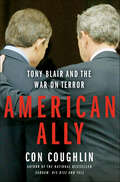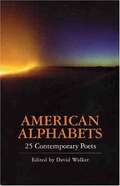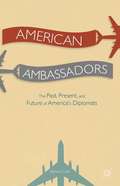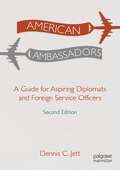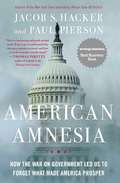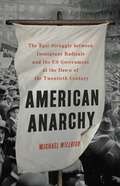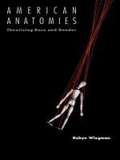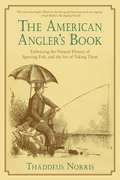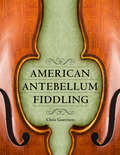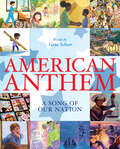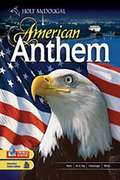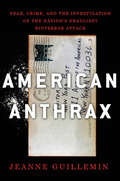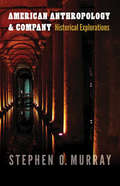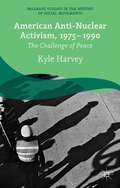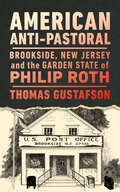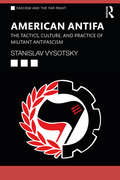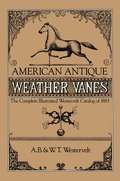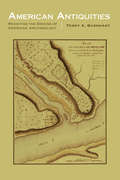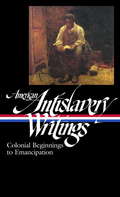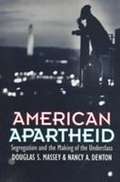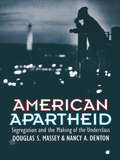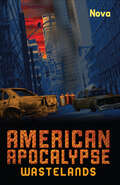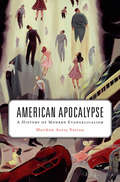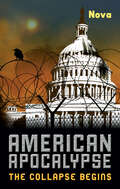- Table View
- List View
American Ally: Tony Blair and the War on Terror
by Con CoughlinAmerican Ally is the definitive account of British Prime Minister Tony Blair's support for the United States in the War on Terror. Drawing on his exclusive access to the key players at the White House and Downing Street, Con Coughlin explains what led Blair to risk his political career for a cause that he truly believed in. Just as Bob Woodward called on insiders to analyze George W. Bush in Bush at War, Coughlin now calls on his own experience and sources to offer a critical analysis and account of Tony Blair at war.Here is an in-depth, probing look at the man who has become America's first ally in the post-9/11 world. Tony Blair's staunch support for the United States since 9/11 has confirmed his position as one of the most important and controversial world leaders of the twenty-first century. In the aftermath of terrorist attacks in London and with Iraq in turmoil, the relationship between Britain and the United States will be critical in determining how future international crises are resolved. American Ally is an essential read for those wishing to make an informed opinion.
American Alphabets: 25 Contemporary Poets
by David WalkerThis anthology introduces readers to twenty-five American poets of the last decades of the twentieth century. Each poet is introduced by a short critical essay, followed by a representative sample of their work. Poets include Agha Shahid Ali, Rita Dove, Mark Doty, and Linda Gregerson.
American Ambassadors
by Dennis C. JettThere are two ways to become an ambassador: a lifetime of dedicated civil service in remote, often life-imperiling locales, or to be a wealthy political benefactor. One route provides grueling work that may never result in this heralded position in the American political landscape, serving some of the world's most challenged nations as they undergo radical change. The other route is considered a gift for financial aid after a successful election campaign. The way in which people become ambassadors of the United States is the result of time-honored traditions and, in some cases, the most thinly veiled form of corruption in American government. American Ambassadors explains where ambassadors come from, what they do, where they go and why they still matter. Former ambassador Dennis Jett offers an insider's look at the complex bureaucratic process that determines who becomes an ambassador and the different paths to the title that are taken by career diplomats and political appointees. Jett describes how an ambassador's effectiveness is measured and why at least four ambassadors in recent years have resigned because of poor performance. It demonstrates how the embassy to which as ambassador is sent can depend on a person's race, gender, religion, sexual orientation and the size of their campaign contributions. And it makes the case for why, in today's ever more globalized world, their work is more important than ever.
American Ambassadors: A Guide for Aspiring Diplomats and Foreign Service Officers
by Dennis C. JettIf you ever wondered who becomes an American ambassador and why, this is the book for you. It describes how Foreign Service officers become ambassadors by rising up through the ranks, and why they typically make up about 70 percent of the total number of ambassadors. It also covers where the other 30 percent come from—the political appointees who get the job because they helped elect the president by supporting him as a campaign contributor, a political ally, or a personal friend. It explains why, despite being illegal and a threat to national security, selling the title of ambassador remains a common practice that is also unique to the United States. It considers why some suggestions for reform are misguided, what might be done, and why who the president is matters so much in determining how well the United States will be represented abroad. This updated and revised edition of Jett's classic book not only provides a timely overview of American ambassadorship for Foreign Service Officers, aspiring diplomats, and interested citizens, but also calls for much-needed reform, describing the dire implications of failing to change our ambassadorial appointments process for the future of American diplomatic practice and foreign policy.
American Amnesia: How the War on Government Led Us to Forget What Made America Prosper
by Jacob S. Hacker Paul PiersonFrom the groundbreaking author team behind the bestselling Winner-Take-All Politics, a timely and topical work that examines what's good for American business and what's good for Americans--and why those interests are misaligned.In Winner-Take-All Politics, Jacob S. Hacker and Paul Pierson explained how political elites have enabled and propelled plutocracy. Now in American Amnesia, they trace the economic and political history of the United States over the last century and show how a viable mixed economy has long been the dominant engine of America's prosperity. Like every other prospering democracy, the United States developed a mixed economy that channeled the spirit of capitalism into strong growth and healthy social development. In this bargain, government and business were as much partners as rivals. Public investments in education, science, transportation, and technology laid the foundation for broadly based prosperity. Programs of economic security and progressive taxation provided a floor of protection and business focused on the pursuit of profit--and government addressed needs business could not. The mixed economy was the most important social innovation of the twentieth century. It spread a previously unimaginable level of broad prosperity. It enabled steep increases in education, health, longevity, and economic security. And yet, extraordinarily, it is anathema to many current economic and political elites. And as the advocates of anti-government free market fundamentalist have gained power, they are hell-bent on scrapping the instrument of nearly a century of unprecedented economic and social progress. In American Amnesia, Hacker and Pierson explain how--and why they must be stopped.
American Anarchy: The Epic Struggle between Immigrant Radicals and the US Government at the Dawn of the Twentieth Century
by Michael WillrichA "lively, fast-paced history" (Adam Hochschild, bestselling author of American Midnight) of America&’s anarchist movement and the government&’s tireless efforts to destroy it In the early twentieth century, anarchists like Emma Goldman and Alexander Berkman championed a radical vision of a world without states, laws, or private property. Militant and sometimes violent, anarchists were heroes to many working-class immigrants. But to many others, anarchism was a terrifyingly foreign ideology. Determined to crush it, government officials launched a decades-long &“war on anarchy,&” a brutal program of spying, censorship, and deportation that set the foundations of the modern surveillance state. The lawyers who came to the anarchists&’ defense advanced groundbreaking arguments for free speech and due process, inspiring the emergence of the civil liberties movement.American Anarchy tells the gripping tale of the anarchists, their allies, and their enemies, showing how their battles over freedom and power still shape our public life.
American Anatomies: Theorizing Race and Gender
by Robyn WiegmanIn this brilliantly combative study, Robyn Wiegman challenges contemporary clichés about race and gender, a formulation that is itself a cliché in need of questioning. As part of what she calls her "feminist disloyalty," she turns a critical, even skeptical, eye on current debates about multiculturalism and "difference" while simultaneously exposing the many ways in which white racial supremacy has been reconfigured since the institutional demise of segregation. Most of all, she examines the hypocrisy and contradictoriness of over a century of narratives that posit Anglo-Americans as heroic agents of racism's decline. Whether assessing Uncle Tom's Cabin, lynching, Leslie Fiedler's racialist mapping of the American novel, the Black Power movement of the 60s, 80s buddy films, or the novels of Richard Wright and Toni Morrison, Wiegman unflinchingly confronts the paradoxes of both racism and antiracist agendas, including those advanced from a feminist perspective.American Anatomies takes the long view: What epistemological frameworks allowed the West, from the Renaissance forward, to schematize racial and gender differences and to create social hierarchies based on these differences? How have those epistemological regimes changed--and not changed--over time? Where are we now? With painstaking care, political passion, and intellectual daring, Wiegman analyzes the biological and cultural bases of racial and gender bias in order to reinvigorate the discussion of identity politics. She concludes that, for very different reasons, identity proves to be dangerous to minority and majority alike.
American Angler's Book: Embracing the Natural History of Sporting Fish, and the Art of Taking Them
by Thaddeus NorrisOver one and a half centuries after its original publication, Thaddeus Norris’s The American Angler’s Book remains a classic heavily sought after by fishing enthusiasts and collectors. Considered father of American fly fishing, Norris’s encyclopedic compilation of nineteenth-century tackle and the making of it, information on diverse fish species, and fishing theories and musings was an immensely important tome that helped popularize sport fishing in the United States. Much of the information is still relevant to pursuers of the modern sport. Topics covered include: Hooks, sinkers, swivels, leaders, snoods, lines, rods, and reels Perch, pike, carp, herring, catfish and eels, salmon, and trout species and behaviors Saltwater and fly fishing methods and tackle Repairs, fly-making, and rod-making Fish breeding And more! "Every American Piscator may feel proud [to own]” this "elegant volume” with "beautifully executed” illustrations, proclaimed The New York Times on the book’s original publication. With information copiously gathered and published during the American Civil War, Norris was a leader in his field. Containing a wealth of exquisite engravings, The American Angler’s Book is a must-have addition to any serious fly-fisher’s collection.
American Antebellum Fiddling (American Made Music Series)
by Chris GoertzenThis unique volume is the only book solely about antebellum American fiddling. It includes more than 250 easy-to-read and clearly notated fiddle tunes alongside biographies of fiddlers and careful analysis of their personal tune collections. The reader learns what the tunes of the day were, what the fiddlers’ lives were like, and as much as can be discovered about how fiddling sounded then. Personal histories and tunes’ biographies offer an accessible window on a fascinating period, on decades of growth and change, and on rich cultural history made audible. In the decades before the Civil War, American fiddling thrived mostly in oral tradition, but some fiddlers also wrote down versions of their tunes. This overlap between oral and written traditions reveals much about the sounds and social contexts of fiddling at that time. In the early 1800s, aspiring young violinists maintained manuscript collections of tunes they intended to learn. These books contained notations of oral-tradition dance tunes—many of them melodies that predated and would survive this era—plus plenty of song melodies and marches. Chris Goertzen takes us into the lives and repertoires of two such young men, Arthur McArthur and Philander Seward. Later, in the 1830s to 1850s, music publications grew in size and shrunk in cost, so fewer musicians kept personal manuscript collections. But a pair of energetic musicians did. Goertzen tells the stories of two remarkable violinist/fiddlers who wrote down many hundreds of tunes and whose notations of those tunes are wonderfully detailed, Charles M. Cobb and William Sidney Mount. Goertzen closes by examining particularly problematic collections. He takes a fresh look at George Knauff’s Virginia Reels and presents and analyzes an amateur musician’s own questionable but valuable transcriptions of his grandfather’s fiddling, which reaches back to antebellum western Virginia.
American Anthem: A Song of Our Nation
by Gene ScheerBased on the song that President Joe Biden quoted in his inaugural address, this picture book celebrates the beauty and diversity of this country and the legacies on which we build our future. As President Joe Biden delivered his inaugural address, he quoted from a song that fully captured his own spirit of service: &“The work and prayers of centuries have brought us to this day. What shall be our legacy? What will our children say? Let me know in my heart, when my days are through—America, America, I gave my best to you.&” It was a sentiment that spoke not only to our new president&’s character, but to the sense of pride in duty and purpose for the sake of a country we hold dear. And it contained a message of quiet patriotism that so many of us hope to share with the next generation. In this new picture book, using the full text of the song President Biden quoted, we do just that. With words that speak to the soul of our nation, and art from twelve different illustrators, all depicting what America means to them, we take readers on a journey through this beautiful country—its history, its struggles, and its dignity—and throughout, we count our own blessings and think about how we can do more to share them with others, and give our best to our country and everyone in it.
American Anthem: Modern American History
by Edward L. Ayers Robert D. Schulzinger Jesús F. de la Teja Deborah Gray WhiteAmerican Anthem, Modern American History: Student Edition writes down the facts and events in the American History. The activities of the people who made the nation and made a difference in the world. The authors published this book in an exciting way to study history, not just facts and dates students needed to know to ace their examinations. It interprates history written by other authors in a different time from the past but in a tasteful and meaningful connection of activities. It has also managed to capture visual evidence of various activities in history, paintings, photographs and other visual media.
American Anthrax: Fear, Crime, and the Investigation of the Nation's Deadliest Bioterror Attack
by Jeanne GuilleminFrom Jeanne Guillemin, one of the world's leading experts on anthrax and bioterrorism, the definitive account of the anthrax investigationIt was the most complex case in FBI history. In what became a seven-year investigation that began shortly after 9/11—with America reeling from the terror attacks of al Qaeda—virulent anthrax spores sent through the mail killed Bob Stevens, a Florida tabloid photo editor. His death and, days later, the discovery in New York and Washington, D.C. of letters filled with anthrax sent shock waves through the nation. Federal agencies were blindsided by the attacks, which eventually killed five people. Taken off guard, the FBI struggled to combine on-the-ground criminal investigation with progress in advanced bioforensic analyses of the letters' contents. While the criminal eluded justice, disinformation swirled around the letters, erroneously linking them to Iraq's WMD threat and foreign bioterrorism. Without oversight, billions were lavished on biomedical defenses against anthrax and other exotic diseases. Worst of all, faith in federal justice faltered. American Anthrax is a gripping tale of terror, intrigue, madness, and cover-up.
American Anthropology and Company: Historical Explorations (Critical Studies in the History of Anthropology)
by Stephen O. MurrayIn American Anthropology and Company, linguist and sociologist Stephen O. Murray explores the connections between anthropology, linguistics, sociology, psychology, and history, in broad-ranging essays on the history of anthropology and allied disciplines. On subjects ranging from Native American linguistics to the pitfalls of American, Latin American, and East Asian fieldwork, among other topics, American Anthropology and Company presents the views of a historian of anthropology interested in the theoretical and institutional connections between disciplines that have always been in conversation with anthropology. Recurring characters include Edward Sapir, Alfred Kroeber, Robert Redfield, W. I. and Dorothy Thomas, and William Ogburn. While histories of anthropology rarely cross disciplinary boundaries, Murray moves in essay after essay toward an examination of the institutions, theories, and social networks of scholars as never before, maintaining a healthy skepticism toward anthropologists’ views of their own methods and theories.
American Anti-Nuclear Activism, 1975–1990
by Kyle HarveyLooking at national peace organizations alongside lesser-known protest collectives, this book argues that anti-nuclear activists encountered familiar challenges common to other social movements of the late twentieth century.
American Anti-Pastoral: Brookside, New Jersey and the Garden State of Philip Roth (CERES: Rutgers Studies in History)
by Thomas GustafsonOne of the best-known novels taking place in New Jersey, Philip Roth’s 1997 American Pastoral uses the fictional hamlet of Old Rimrock, NJ as a microcosm for a nation in crisis during the cultural upheavals of the 1960s-70s. Critics have called Old Rimrock mythic, but it is based on a very real place: the small Morris county town of Brookside, New Jersey. American Anti-Pastoral reads the events in Roth’s novel in relation to the history of Brookside and its region. While Roth’s protagonist Seymour “Swede” Levov initially views Old Rimrock as an idyllic paradise within the Garden State, its real-world counterpart has a more complex past in its origins as a small industrial village, as well as a site for the politics of exclusionary zoning and a 1960s anti-war protest at its celebrated 4th of July parade. Literary historian and Brookside native Thomas Gustafson casts Roth’s canonical novel in a fresh light as he studies both Old Rimrock in comparison to Brookside and the novel in relationship to NJ literature, making a case for it as the Great New Jersey novel. For Roth fans and history buffs alike, American Anti-Pastoral peels back the myths about the bucolic Garden State countryside to reveal deep fissures along the fault-lines of race and religion in American democracy.
American Antifa: The Tactics, Culture, and Practice of Militant Antifascism (Routledge Studies in Fascism and the Far Right)
by Stanislav VysotskySince the election of President Trump and the rise in racist and white supremacist activity, the militant antifascist movement known as antifa has become increasingly active and high profile in the United States. This book analyzes the tactics, culture, and practices of the movement through a combination of social movement studies and critical criminological perspectives. Based on extensive fieldwork and interviews with activists, this book is the first scholarly sociological analysis of contemporary antifascist activism in the United States. Drawing on social movement studies, subculture studies and critical criminology, it explains antifa's membership, their ideology, strategy, tactics and use of culture as a weapon against the far right. It provides the most detailed account of this movement and also cuts through much of the mythology and common misunderstandings about it. This book will be of interest to scholars and students in sociology, political science, anthropology, criminology, and history; however, a general audience would also be interested in the explanation of what drives antifa tactics and strategy in light of the high-profile conflicts between fascists and antifascists.
American Antique Weather Vanes: The Complete Illustrated Westervelt Catalog of 1883 (Dover Jewelry and Metalwork)
by A. B. WesterveltWeather vanes were used by the ancient Greeks a hundred years before the birth of Christ; by early Scandinavians on their ships; and were common throughout England since William the Conqueror, and throughout Europe since the French Revolution. American vanes were recorded since the seventeenth century -- among the first known is the copper cockerel, made in 1656 for the Dutch Reformed Church at Albany. The weather vane found a welcome home in the expanding America of the eighteenth and nineteenth centuries. It was a jaunty bit of decoration that served an important utilitarian function and enlivened the whole landscape with its humorous and homespun motifs, bold and vigorous design, and spirited air of American individualism and independence.By the late nineteenth century weather vane design and manufacture had reached full maturity. There were several firms throughout the United States specializing in weather vanes, some of which issued catalogs displaying their wares. Among the largest and most important of these companies was A. B. & W. T. Westervelt of New York City, whose extensive illustrated 1883 catalog, featuring over 550 copper weather vanes and finials, is herein reprinted.This excellent primary source by one of the principal manufacturers of American weather vanes offers an extraordinarily wide range of styles and motifs, including: horse with sulky and driver, cow or bull, gun and cap, goddess of liberty, dog, ram or sheep, Indian chief, hook and ladder with number, oxen, ocean steamer, Roman banneret and scroll, rooster, cannon, fish, pen, locomotive and tender, initials, lion, liberty cap and arrows, malter's shovel and brew barrel, and many more. Vanes are illustrated with line engravings, are especially well suited to reproduction (all royalty-free), and are accompanied by relevant information on size, materials, and original prices.Indispensable for the architect, antique collector, and historian, this collection of authentic weather vane designs will also prove to be an unusually rich source of royalty-free art and graphic inspiration for the artist, designer, and crafter.
American Antiquities: Revisiting the Origins of American Archaeology (Critical Studies in the History of Anthropology)
by Terry A. BarnhartWriting the history of American archaeology, especially concerning eighteenth and nineteenth-century arguments, is not always as straightforward or simple as it might seem. Archaeology’s trajectory from an avocation, to a semi-profession, to a specialized, self-conscious profession was anything but a linear progression. The development of American archaeology was an organic and untidy process, which emerged from the intellectual tradition of antiquarianism and closely allied itself with the natural sciences throughout the nineteenth century—especially geology and the debate about the origins and identity of indigenous mound-building cultures of the eastern United States. Terry A. Barnhart examines how American archaeology developed within an eclectic set of interests and equally varied settings. He argues that fundamental problems are deeply embedded in secondary literature relating to the nineteenth-century debate about “Mound Builders” and “American Indians.” Some issues are perceptual, others contextual, and still others basic errors of fact. Adding to the problem are semantic and contextual considerations arising from the accommodating, indiscriminate, and problematic use of the term “race” as a synonym for tribe, nation, and race proper—a concept and construct that does not, in all instances, translate into current understandings and usages. American Antiquities uses this early discourse on the mounds to frame perennial anthropological problems relating to human origins and antiquity in North America.
American Antislavery Writings: Colonial Beginnings to Emancipation
by Various James G. BaskerFor the 150th anniversary of the Emancipation Proclamation, here is a collection of writings that charts our nation's long, heroic confrontation with its most poisonous evil. It's an inspiring moral and political struggle whose evolution parallels the story of America itself. To advance their cause, the opponents of slavery employed every available literary form: fiction and poetry, essay and autobiography, sermons, pamphlets, speeches, hymns, plays, even children's literature. This is the first anthology to take the full measure of a body of writing that spans nearly two centuries and, exceptionally for its time, embraced writers black and white, male and female. Benjamin Franklin, Thomas Paine, Phillis Wheatley, and Olaudah Equiano offer original, even revolutionary, eighteenth century responses to slavery. With the nineteenth century, an already diverse movement becomes even more varied: the impassioned rhetoric of Frederick Douglass and William Lloyd Garrison joins the fiction of Harriet Beecher Stowe, Louisa May Alcott, and William Wells Brown; memoirs of former slaves stand alongside protest poems by John Greenleaf Whittier, Henry Wadsworth Longfellow, and Lydia Sigourney; anonymous editorials complement speeches by statesmen such as Charles Sumner and Abraham Lincoln. Features helpful notes, a chronology of the antislavery movement, and a16-page color insert of illustrations.
American Apartheid: Segregation and the Making of the Underclass
by Nancy Denton Douglas MasseyA study of segregation as the root of many problems facing African-Americans today.
American Apartheid: Segregation and the Making of the Underclass
by Douglas MasseyThis powerful and disturbing book clearly links persistent poverty among blacks in the United States to the unparalleled degree of deliberate segregation they experience in American cities. American Apartheid shows how the black ghetto was created by whites during the first half of the twentieth century in order to isolate growing urban black populations. It goes on to show that, despite the Fair Housing Act of 1968, segregation is perpetuated today through an interlocking set of individual actions, institutional practices, and governmental policies. In some urban areas the degree of black segregation is so intense and occurs in so many dimensions simultaneously that it amounts to “hypersegregation.” Douglas Massey and Nancy Denton demonstrate that this systematic segregation of African Americans leads inexorably to the creation of underclass communities during periods of economic downturn. Under conditions of extreme segregation, any increase in the overall rate of black poverty yields a marked increase in the geographic concentration of indigence and the deterioration of social and economic conditions in black communities. As ghetto residents adapt to this increasingly harsh environment under a climate of racial isolation, they evolve attitudes, behaviors, and practices that further marginalize their neighborhoods and undermine their chances of success in mainstream American society. This book is a sober challenge to those who argue that race is of declining significance in the United States today.
American Apocalypse Wastelands
by NovaIn this post-apocalyptic novel, millions struggle to survive in the wasteland America has become as one man fights to maintain its founding promise.Starvation, violence and death run rampant in the remains of our once-proud country. Federal troops, commissioned to protect the homeland, have turned their guns on the lawless population. Citizens find shelter in government safe zones while ruthless gangs enforce their will outside the camps. When the military transforms Washington’s life-saving food bank into a gun collection center in order to disarm all but the soldiers themselves, riots ensue. Weary of the militaristic government’s intent to render the citizens defenseless, America’s remaining patriots begin a mass migration out of the camps in search of refuge.American Apocalypse Wastelands tells of a young man discovering the role he must play to defend himself, others and his country as everything around him crumbles. It is a revised edition of American Apocalypse II: Refuge.
American Apocalypse: A History of Modern Evangelicalism
by Matthew Avery SuttonThe first comprehensive history of modern American evangelicalism to appear in a generation, American Apocalypse shows how a group of radical Protestants, anticipating the end of the world, paradoxically transformed it. Matthew Avery Sutton draws on extensive archival research to document the ways an initially obscure network of charismatic preachers and their followers reshaped American religion, at home and abroad, for over a century. Perceiving the United States as besieged by Satanic forces: communism and secularism, family breakdown and government encroachment, Billy Sunday, Charles Fuller, Billy Graham, and others took to the pulpit and airwaves to explain how Biblical end-times prophecy made sense of a world ravaged by global wars, genocide, and the threat of nuclear extinction. Believing Armageddon was nigh, these preachers used what little time was left to warn of the coming Antichrist, save souls, and prepare the nation for God's final judgment. By the 1980s, President Ronald Reagan and conservative Republicans appropriated evangelical ideas to create a morally infused political agenda that challenged the pragmatic tradition of governance through compromise and consensus. Following 9/11, the politics of apocalypse continued to resonate with an anxious populace seeking a roadmap through a world spinning out of control. Premillennialist evangelicals have erected mega-churches, shaped the culture wars, made and destroyed presidential hopefuls, and brought meaning to millions of believers. Narrating the story of modern evangelicalism from the perspective of the faithful, Sutton demonstrates how apocalyptic thinking continues to exert enormous influence over the American mainstream today.
American Apocalypse: A History of Modern Evangelicalism
by Matthew Avery SuttonIn the first comprehensive history of American evangelicalism to appear in a generation, Matthew Sutton shows how charismatic Protestant preachers, anticipating the end of the world, paradoxically transformed it. Narrating the story from the perspective of the faithful, he shows how apocalyptic thinking influences the American mainstream today.
American Apocalypse: The Collapse Begins (9781569759035 Ser.)
by NovaA young man comes of age as he fights to survive amid the downfall of America in this post-apocalyptic thriller.With the economy in free fall, the government crippled by indecision, the streets taken over by desperate mobs, and the fragile institutions of civilization crumbling, America suffers a full-scale collapse. Amid the destruction and anarchy, a young man finds himself homeless and alone on the outskirts of Washington, D.C., facing certain death unless he can master survival skills he never imagined needing. An innocent casualty of the chaos, this young patriot must discover his inner strength and defiant courage as he comes of age in the desolation of the country’s languishing capital. Fending off violent citizens in a wasteland of looting and mayhem, the protagonist emerges as an ultimate force of justice in a lawless land. This compelling, fast-paced novel pulls readers in and lets them experience firsthand what life in the United States could be when its teetering society finally falls.
